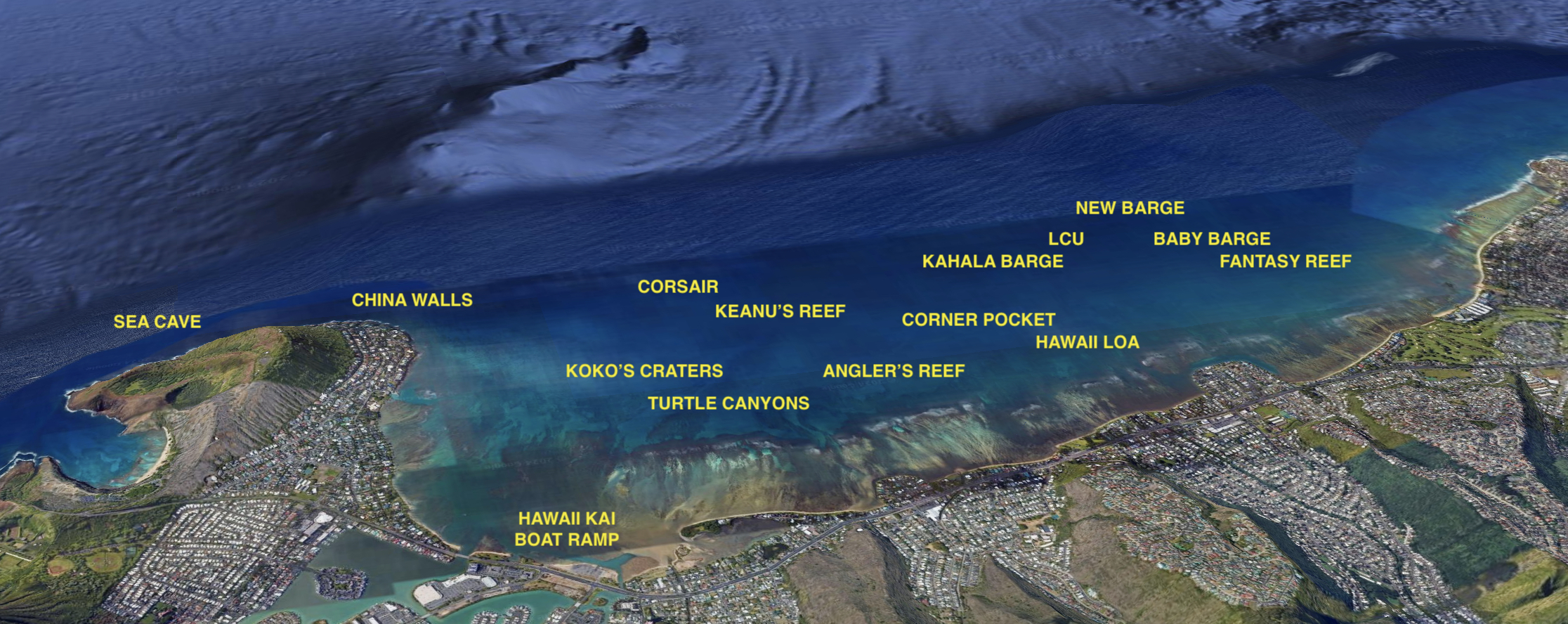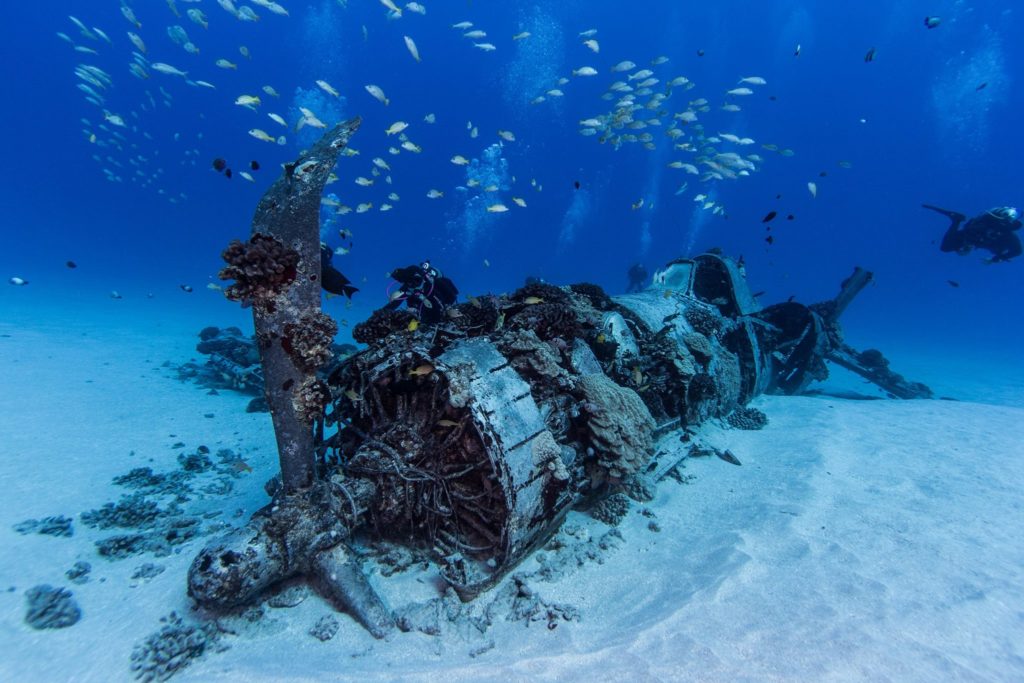Maunalua Bay Dive Sites
Click a location to learn more about the different sites we use!

Hawaii Kai Boat Ramp
The meeting place for our boats! The boat ramp itself is the rightmost location while facing the water. Please meet us here for your boat tours roughly 15 minutes before your scheduled charter!
Corsair

Depth 100-110 ft
One of Oahu’s only natural wrecks is the US. Marine Corps F-4(U-1A) Corsair (33’ long, 41’ wingspan). In April 1945, 2nd Lt. William Holden took off from Molokai field on a short ferry flight to Ewa field. Twenty minutes into the flight, engine oil began spraying onto the windshield, followed by total engine failure. Lt. Holden safely performed a water landing, after which the aircraft slowly sank to the bottom. The plane is intact and rests on a large broad sand plain in 105-110’ of water. The site is surrounded by a large colony of Hawaiian Garden Eels and divers often encounter Giant Moray, Yellowtail Snappers, Hawaiian Squirrelfish, Snake Eel, Leaf Scorpionfish, Hawaiian Knifefish, Knobby Seastars, and Harlequin Shrimp.
Sea Cave
45-85+ ft
The Sea Cave is a natural cavern formed on the edge of a seaside cliff. The entrance to the cave is about 55’ underwater and slopes up to around 25’. The roof of the cave is open midway into the cave offering plenty of light, but dive lights are certainly helpful. Inside the cave, divers can usually find Green turtles, Whitetip Reef sharks, Linkia stars, Hairy Yellow Hermit crabs, Fine-needled urchins, at least eight species of nudibranchs, Moorish Idols, Cardinalfish, Bigeyes, and Soldierfish. Outside the cave the cliffs continue down to about 95’ and are covered in dense coral growth. Since this is often a high current area, visibility is usually excellent and schools of Pyramid, Milletseed, Thompson’s, and Raccoon butterflyfish, Longfin Bannerfish and Oval Chromis are commonly seen feeding on plankton in midwater. Red Velvet and Purple Velvet stars, Rough-spined and Slate Pencil urchins, Green Turtles, Flagtail Tilefish, and Whitemouth Morays. This is an advanced dive due to the depths, currents, waves, and overhead environment. This site has a mooring outside the cave, but is more often planned as a drift dive. This site generally has excellent visibility.
China Walls
25-55 ft (No Mooring Buoy)
A continuation of the same rock face that dominates Sea Cave and Spitting Cave, this site has less coral and fish. The bottom slopes to a broad sand and rubble plain. Visibility is variable and surge can be significant. Due to the depth, currents, surge, and lack of a mooring ball, this is considered an advanced dive site. Double-spotted Queenfish, Multiband Butterflyfish, Yellowfin Surgeonfish, Whitesaddle goatfish, Redspotted Sandperch, Rainbow Runners, and Mackeral Scad can all be found here.
Turtle Canyons
20-35 ft Unavailable on Sundays
While there are no canyons, there are small ridges and valleys throughout this dive site. Coral cover is variable with some areas of dead reef and bare rock to places with dramatic corals competing to outgrow one another. There is a large sand flat on the south side of the site with small rock outcrops near the main reef. Spotted boxfish, Potter’s and Flame angelfish, Saddle wrasse, Partridge Tun snails, Slipper Lobster, Zebra Morays, Horned Helmet Snails, Heart urchins, Collector urchins, and numerous butterflyfish are all common. With its proximity to Koko Craters, this site regularly has Green turtles cruise by. This site has very variable visibility.
Koko's Craters
30-40 ft Unavailable on Sundays
Koko's Craters is a broad flat plain with a series of depressions sunk into the bottom. The edges of these craters are undercut and provide excellent places for Green turtles to sleep. This site is an active turtle cleaning station and divers are often rewarded with close encounters with turtles hovering in midwater getting cleaned by reef fish. There is very little coral at this site, but other aquatic life commonly encountered are Potter’s angelfish, big schools of Yellowfin Surgeonfish, schools of Porcupinefish, Titan and Devil Scorpionfish, Orangeband Surgeonfish, Peacock flounder, Blackbar razorfish, Rainbow Runners, Hawaiian Sargent guarding their purple egg masses that encrust the bottom, Saddle wrasse, Snowflake Moray, Pinktail Triggerfish, Leopard Cone snails, and lobster. On rare occasions, divers have been lucky enough to see Tiger sharks and Hawaiian Monk Seals. Don’t forget to look for several Buddha statues too. Visibility is highly variable at this site.
Keanu's Reef
65-75 ft (No Mooring Bouy)
Keanu’s Reef is a broad plain of flat rock sheets dispersed among a rubble and sand bottom. There are small coral heads mixed throughout the site. A large steel anchor usually defines the starting point of this drift dive. There is no mooring buoy and it is a deep dive with nearly constant depth making this an advanced dive. Whitemouth and Yellowmargin Moray, schools of porcupinefish, Squirrelfish, Soldierfish, Cardinalfish, and Chocolate Dip Chromis are all common. Less commonly encountered are Longtail dragonet, Bicolor Anthias, Yellow-green goby, Varicose Nudibranch, Knobby seastars, Crown-of-thorns stars, and transient schools of Mackerel Scad.
Angler's Reef
35-45 ft
Angler’s is a linear ledge which runs east-west and drops off about 4-5’. The ocean side of the ledge is a flat pavement-like plain, the shore side is a sand flat interspersed with small rock outcrops. The top of the ledge has sporadic coral colonies and lots of urchins. Yellowmargin, Whitemouth, and Stout Morays are common as are several varieties of Soldierfish and Squirrelfish. The reef is named for the many Anglerfish that can be found here (both Commerson’s and Painted). In addition, Hawaiian Dascyllus, Porcupinefish, Saddle wrasse, Milletseed and Fourspot Butterflyfish, Therese’s Sole, Tiger, Isabella’s and Honey cowries, Horned Helmet snails, and Heart Urchins, Bullethead parrotfish, Black Durgeons, Cushion star, and Day octopus are common. Visibility is highly variable at this site.
Corner Pocket
50-55 ft
Corner Pocket is a flat rubble plain with several rock outcrops covered in moderate coral coverage. Fisher’s star, Sea Biscuits, and Heart urchins are common in the rubble plain, while in and on the rocks are Blue-black and Slate Pencil urchins, Sleepy Sponge crabs, and Blue Dragon Nudibranchs. Inside the branches of the corals are Guard Crabs, several types of Scorpionfish, Coral Crouchers, and shrimps. Large schools of Bluestripe snappers and Longfin Bannerfish are always present, as are Milletseed Butterflyfish, Longnose butterflyfish, Titan scorpionfish, Bridled triggerfish, Hawaiian fantail filefish, Arc-eye Hawkfish, Hawaiian Squirrelfish, Sergeant Majors, Midget Chromis, Belted wrasse, and Palenose parrotfish. This site, which usually has exceptional visibility, can have strong tidal currents.
Hawaii Loa
20-35 ft
Hawaii Loa is an extension of the ridge by the same name found onshore. The main site is a shallow crater which rings a small sand flat. This site has variable coral coverage, from relatively sparse to exceptionally dense. As a shallower site there is plenty of time to swim around and explore the reef. Divers regularly find Brown, Blueline, Goldring, and Orangeband Surgeonfish. Hawaiian Sergeant, Whitemouth Moray, Yellowhead Moray, Speckled scorpionfish, Commerson’s anglerfish, Wedgetail and Picasso Triggerfish (both famously known locally as Humuhumu-nukunuku-a-pua’a- or just HumaHuma), Partridge Tun snails, and Black Durgeons. The exceptionally rare and Endangered Hawksbill turtles have been seen on occasion at this site as are Spotted Eagle Rays. This site has very variable visibility.
New Barge
Depth 85-95 ft
New Barge was a utility barge of the US Navy. Donated to the State of Hawaii for the artificial reef program, it was scuttled in 1998. It rests upright and intact on a slight slope with the maximum depth of about 95’. This 100’ long barge has numerous internal baffles and multiple access holes to allow divers to penetrate into the wreck. North and south of the wreck are large boulder and ‘Z’ block piles. Divers often encounter schools of Giant Trevally as well as Bluefin Trevally, Alamaco Jacks, Spotted Queenfish, Milletseed Butterflyfish, Porcupinefish, Textile Cone Snails, Crown-of-Thorns Seastars, Unicornfish, and Green Turtles. Whitetip Reef Sharks and Spotted Eagle Rays are regularly spotted transiting through the area.
LCU (Landing Craft Utility) - East
Depth 85-90 ft
The Landing Crafty Utility wreck (better known as the LCU) was a US Navy ship used for amphibious beach landings. This vessel is one of three LCU's donated by the Pearl Harbor Naval Shipyard to be used as part of the State of Hawaii’s artificial reef program. It was scuttled in 90’ of water in 1998. It lies upside down (with room for divers to explore underneath) on a flat rubble plain with a large area of ‘Z’ blocks scattered around the site. This site often houses Whitetip Reef Sharks, Tinker’s Butterflyfish, Blacklip Butterflyfish, Yellowmargin and White-Spotted Morays, Cushion Stars, Wire Corals, and numerous Soldierfishes.
Baby Barge (aka Keehi Barge)
Depth 65-75 ft
The Keehi Barge, was one of the vessels that needed to be removed from Keehi Lagoon (thus its name) by the State of Hawaii- Division of Boating and Ocean Recreation. The history of Baby Barge is less understood than other wrecks in Manualua Bay. It may have been purchased from the Navy, or it may have been a derelict and abandoned vessel. Though it is the most recent wreck (scuttled in 1994), it is the least intact of the wreck sites. It rests in approximately 70’ of water on the edge of an historic river bank which drops off 6-10’. The wreck itself is splayed open to reveal the ribs and interior. The bottom surrounding the wreck is composed of flat rock sheets with sporadic corals and sponges. Green Turtles are frequently encountered here, as are Sandbar Sharks, Yellowstripe Goatfish, Trumpetfish, Yellowtail Filefish, Longnose Butterflyfish, Blue Dragon Nudibranchs, and Slipper Lobster.
Fantasy Reef (aka Fantasea) Reef
35-50 ft
The site is a series of sculpted rock outcrops and ridges set upon a broad rubble plain. There are numerous overhangs, ledges, and swim-throughs large enough for divers. Coral cover is relatively high. Large schools of Humpnose bigeye bream, as well as Yellow Tangs, Potter’s Angelfish, Devil Scorpionfish, Slate Pencil and Collector urchins, Sandbar sharks, Whitetip Reef sharks, Redbarred Hawkfish, Great Barracuda
Kahala Barge (aka CB Barge)
Depth 90-95 ft
Originally known as the CB Barge, this 200' vessel was damaged by a storm while on a job in Waianae (possible working on the sewer outfall extension). It was kept afloat with a large air bladder and towed into Honolulu Harbor. Following an inspection, it was deemed too costly to be repaired and donated to DAR. Scuttled in 1985, it rests in 95’ of water on a broad flat sand plain adjacent to a flat rubble plain. The wreck is mostly intact with numerous opportunities to penetrate. Divers regularly encounter Whitetip Reef Sharks, Giant Trevally, Yellowmargin Moray, Pyramid Butterflyfish, Longfin Bannerfish, Hawaiian Dascyllus, Indigo Dartfish, Wire Corals, and large, shrub-like Black Corals.

